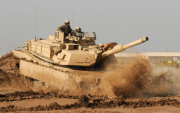|
Memento posted:So is that about 13 MoA? I don’t know how relevant MoA is to something like a naval rifle; There are just a ton more external variables to correct for, and you’re generally measuring accuracy MUCH later in the projectile’s flight than with a small arm. If you were to shoot the 16”/50 at a paper target on a barge at a couple thousand yards, that might be a more relevant comparison to a 1MoA capable shoulder rifle. CEP is probably a better measure of effectiveness. I don’t think you’d get anything like 12 or 13MoA out of a .308 rifle shot thirty degrees up in the air at a target four miles away, no matter how advanced your fire control. 
|
|
|
|

|
| # ? Jun 3, 2024 14:42 |
|
gohuskies posted:You're likely thinking of Washington vs Kirishima at 2nd Guadalcanal. The Helena got first round straddles I believe twice. US radar fire control was good enough that they could see the splashes, which is just uncanny.
|
|
|
|
During WWII if you were a fit 21 year old in your nation’s capitol “from a small farming town who lost your ID on the train” are there any nations that wouldn’t let a John Smith sign up?
|
|
|
|
Hyrax Attack! posted:During WWII if you were a fit 21 year old in your nation’s capitol “from a small farming town who lost your ID on the train” are there any nations that wouldn’t let a John Smith sign up? Showing up in Moscow with no ID during the war would get you arrested immediately.
|
|
|
|
Edgar Allen Ho posted:In Europe, the Red Army can absolutely meet or exceed the US in terms of guns fielded and shots hitting nazis. It's communication that makes the US stand out. Every artillery unit has trained, dedicated forward observers moving in contact with the infantry and armour, spotter planes above, and the necessary radio and telephone equipment for a squad of grunts to call for a strike here, now, and get an accurate barrage. The Red Army specifically lacked trained forward observers and radio operators. Combine this with their general shortage of officers and consequently lean staffs and lack of subordinate commanders in units and you get a situation where although there are alot of guns they aren't necessarily able to provide rapid and responsive tactical support. The Soviets tended towards devastating pre-planned barrages in support of the opening moves of offensives, but once they got moving Soviet units would often quickly outrun their artillery support. In any case the conditions noted above meant that rapid artillery support often could not be effectively utilized. Also of note is that, I think especially from late 41/42 onwards, most Soviet artillery assets were held at the corps and army level in detached battalions and regiments (occasionally formed into artillery corps and armies IIRC), a Soviet division therefore was not only smaller than a Western or German equivalent, but had few integral artillery assets beyond lighter pieces. I believe this led to the smallest operational unit in the Red Army more often the corps or armies than its divisions.
|
|
|
|
LatwPIAT posted:Both the German and the British/Commonwealth squad is built on the idea that you have a base of fire in the machine gun (whether Bren or MG34/42). The rifle element protects the machine gun while it suppresses the enemy, and when the enemy is suppressed, the rifle element moves up to destroy the target with grenades and small arms fire. This has been the standard of squad-level infantry tactics since WWII. Occasionally you see squads without MGs at all, but typically they're expected to operate close to an MG-armed APC that can act as a firebase. This is not really true and per UK doctrine the MG group works separately from rifle groups to deliver fire support. Like this:  Interestingly I found the below from a WW2 vet on platoon automatic weapons in a British Army Review, I can't actually find a direct link to the article but it's a public document.  
|
|
|
|
Memento posted:So is that about 13 MoA? It’s impossible to tell for two reasons: The first is that the data given is for a fifteen-round volley fired by three guns simultaneously, which is going to introduce a factor of accuracy while quoted MOA for small arms is typically a measure of precision. The second is that how you measure to get a precision figure in minutes of arc for a rifle has significant impact on the value of the figure. It’s typically measured as the maximum distance within a group of shots, sometimes averaged over multiple groups. To sensibly compare a rifle figure to a naval gun figure, it’s necessary to know how the precision of the rifle was measured in the first place. knox_harrington posted:This is not really true and per UK doctrine the MG group works separately from rifle groups to deliver fire support. Like this: What’s this diagram showing? LatwPIAT fucked around with this message at 09:41 on Dec 10, 2021 |
|
|
|
TooMuchAbstraction posted:I remember hearing that the British maps were just hideously organized, though, which really hampered their ability to rapidly get shots on target. Where did you hear that? OS mapping design is and was in general really good. quote:IIRC both Britain and Germany relied heavily on spotters, i.e. intermediaries who could see where the shells actually landed, and communicate back to the artillery so their aim could be adjusted. The US just made a poo poo-ton of highly-detailed maps with better organization. They also made firing tables for every conceivable situation, so that if you needed to know how much propellant to use to hit a target 1.275 miles away and 100 feet above you when the wind is 15 mph out of the southwest, you could just look up a number instead of having to do the math yourself. Forward observation is absolutely key for artillery fire missions and firing / range tables (which everyone had) don't remove the need for this. How do you think they know where to fire?
|
|
|
|
LatwPIAT posted:What’s this diagram showing? ?? An infantry platoon attack with machine gun support
|
|
|
|
Anyone talking about ww2 artillery use should propably take a look at https://en.m.wikipedia.org/wiki/Battle_of_Tali%96Ihantala ; Allies in general tended to have this organic quality of ”poo poo ton more radios and guns” at their side most of the time which enabled the famed ”you can call indirect at a very low tactical level” aswell as especially in the US case the added benefit of ”unlimited trucks” trait which is essential to relocate and resupply during offensives. But this is an example of amassing enormous amount of guns in huge variety - just like Finnish small arms were ”Every caliber you can buy and /or loot between 1918-1943” their FA had artillery from all over ww1 and ww2 - including stuff like old imperial russian guns - orchestrating them all to outshoot the Red Army.
|
|
|
|
Valtonen posted:Anyone talking about ww2 artillery use should propably take a look at https://en.m.wikipedia.org/wiki/Battle_of_Tali%96Ihantala ; Battle of Tali-Ihantala
|
|
|
|
SerCypher posted:You use both, but naval artillery against troops in the open was incredibly effective. Not just incredibly effective when the big boys let go. HMS Nelson was called on to do a fire support mission against a German attack spearheaded by five Tigers. Nine sixteen inch guns were so powerful that even an indirect shot flipped a Tiger tank onto its roof. The full fury of a battleships sixteen to eighteen inch guns was something to behold, but at the same time could very well be overkill for fire support of land fighting. Plus replacing a worn smooth naval gun is much more difficult and time-consuming than land based artillery.
|
|
|
|
Naval guns also fire flatter so the probable error range is a lot bigger than land artillery.
|
|
|
|
mllaneza posted:The Helena got first round straddles I believe twice. US radar fire control was good enough that they could see the splashes, which is just uncanny. As I understand it the good sets not only could see the splashes but distinguish between them and the hard contacts. The number of salvoes fired by the different battleships at Surigao Strait was strongly determined by whether the ships had the newest radar to let them maintain contact through the splashes of everyone's guns. That was a bad night to be a Japanese battleship crewman. LatwPIAT posted:It’s impossible to tell for two reasons: Also it's over a long distance. Precision of the same shots decreases as distance goes up as more and more external ballistics are introduced into the picture. Mechanical accuracy of a rifle at 1 km is very unlikely to be the driving factor of the dispersion of a small arms system even if it's physically locked in a consistent place, and naval shellfire is absolutely firing at comparably extended ranges. xthetenth fucked around with this message at 15:53 on Dec 10, 2021 |
|
|
|
One of my favorite little details about that kind of thing was that during the Korean War, it was a persistent rumor among the North Korean forces that the Iowas were secretly armed with atomic shells. 16" guns leave big craters.
|
|
|
|
There's a neat infographic about the size of artillery craters I have from a Soviet textbook. 152 mm is a piddly 6 inches, but still makes a hole big enough for a person to stand in.
|
|
|
|
knox_harrington posted:Where did you hear that? OS mapping design is and was in general really good. Sorry, I do not remember. This is why I stated at the beginning that I'm not an expert and am operating from memory. You are more than welcome to provide additional corrections. (edit: Maybe I was thinking of WW1?) TooMuchAbstraction fucked around with this message at 16:14 on Dec 10, 2021 |
|
|
|
TooMuchAbstraction posted:Sorry, I do not remember. This is why I stated at the beginning that I'm not an expert and am operating from memory. You are more than welcome to provide additional corrections. yeah, i think that someone posted about that wrt ww1
|
|
|
|
Nenonen posted:Your link doesn't work, this should work better: I guess you might know something about General Nenonen? Is there some detailed write-up on the system that Nenonen & co invented? I know that in practice it meant that several artillery batallions fired at the same target in Tali-Ihantala. How did they do it? One FO spots a target and all tubes just decide to fire at this specific spot?
|
|
|
|
Ensign Expendable posted:There's a neat infographic about the size of artillery craters I have from a Soviet textbook. This is very neat
|
|
|
|
Ensign Expendable posted:There's a neat infographic about the size of artillery craters I have from a Soviet textbook. Confirmed by Steel Division 2.
|
|
|
|
Pyle posted:I guess you might know something about General Nenonen? Is there some detailed write-up on the system that Nenonen & co invented? I know that in practice it meant that several artillery batallions fired at the same target in Tali-Ihantala. How did they do it? One FO spots a target and all tubes just decide to fire at this specific spot? Nenonen probably knows better, but I've understood https://en.wikipedia.org/wiki/Fire_Correction_Circle was a major contributor.
|
|
|
|
knox_harrington posted:An infantry platoon attack with machine gun support I'm not sure what your point is: the platoon assaults while machine guns provide support fire, yes, but that's not the same as the squad (having the ability to) assault with one team while another provides the base of fire. Things are going to be different at the platoon level from the squad level (though principally you still use a firebase and an assault element).
|
|
|
|
Maybe they're referring to machinegun support from a higher level. I.e., a USMC Rifle Company has a Weapons platoon that provides support to line platoons.
|
|
|
|
LatwPIAT posted:I'm not sure what your point is: the platoon assaults while machine guns provide support fire, yes, but that's not the same as the squad (having the ability to) assault with one team while another provides the base of fire. Things are going to be different at the platoon level from the squad level (though principally you still use a firebase and an assault element). Maybe you're using "squad" to mean something other than section or fire team, but under the UK model there is not necessarily a GPMG in a section at all and by the book they are platoon weapons. So I disagree with what you wrote below. LatwPIAT posted:Both the German and the British/Commonwealth squad is built on the idea that you have a base of fire in the machine gun (whether Bren or MG34/42)... Anyway automatic suppressing fire is key to infantry tactics however it's organised. My original question was more about the idea where, as I understand it, the German WW2 infantry squad basically existed to keep the MG fed, whereas for Brits the Bren was there supporting the rifles.
|
|
|
|
knox_harrington posted:Anyway automatic suppressing fire is key to infantry tactics however it's organised. My original question was more about the idea where, as I understand it, the German WW2 infantry squad basically existed to keep the MG fed, whereas for Brits the Bren was there supporting the rifles. Didn't someone post rather recently about how British webbing on riflemen let them carry Bren mags, specifically so that they could keep the MG fed?
|
|
|
|
Jobbo_Fett posted:Didn't someone post rather recently about how British webbing on riflemen let them carry Bren mags, specifically so that they could keep the MG fed? 37 pattern webbing wouldn't require anything special; anyone could clip a Bren magazine pouch onto their belt.
|
|
|
|
Cessna posted:37 pattern webbing wouldn't require anything special; anyone could clip a Bren magazine pouch onto their belt. I thought they had purpose built webbings with them included, not simply clip on. My bad.
|
|
|
|
Jobbo_Fett posted:Didn't someone post rather recently about how British webbing on riflemen let them carry Bren mags, specifically so that they could keep the MG fed? LatwPIAT posted:It’s pretty interesting how much Commonwealth squad-level tactics were organized around the Bren. A lot of WWII forces gave the soldier belt pouches to carry clips for their rifles. The British instead carried ammunition in bandoliers (which were issued from the factory as one loaded unit, conveniently) slung over the body as necessary, but the webbing itself only carried two pouches intended to hold two loaded and one empty Bren magazines and a rolled-up bandolier for reloading the magazines. More ammunition is carried for the Bren than the soldier’s rifle, and rifle ammo is handed out in bandoliers as needed but the Bren magazines are “always” carried in pouches on the body.
|
|
|
|
MVP
|
|
|
|
Thanks. https://www.canadiansoldiers.com also has this reconstruction of the Utility Pouches, which were typically worn two at a time and slung over the shoulders when issued to troops. Each can hold three Bren mags, three mortar bombs, or two Boys’ magazines.  The bandoliers were also issued as needed and either rolled up into the belt (or possibly utility) pouches. Here’s a Sten pouch to illustrate the concept, which you probably can’t roll up: the pouches were too short to hold Sten magazines. Interestingly, the bandoliers very rarely appear in photos, which makes me suspect they often ended up in the pouches, cutting into the Bren magazine allotment. (Though since once of those is supposed to be carried unloaded I can’t help but suspect some people figured they might as well load them before battle and carry an addition 28-30 rounds on their body. The only reason I can imagine you’d want to not do that is because you’re using the pouch-bandolier as dual-purpose ammo reserve, or some old wives’ tale about storing springs compressed.)  According to battleorder.org the German infantry squad we’re supposed to carry ten clips each in belt pouches (at least with the new org of 1944). The MG34/42 shooter seems to have carried the gun with one 50-round assault drum, while the MG assistant carried four assault drums and a 300-round belt box. Early in the war the squad was allotted and ammo bearer who carried an addition two belt boxes, though by 1944 the squads are downsized and these boxes handed to some poor sods in the squad. It appears that on paper the belts weren’t really distributed to the riflemen any further than the two belt boxes, though it’s entirely possible some squads found a way to divvy up the belts among the soldiers to take a load off the designated erzatz-ammo bearers. There’s a lot to praise about the German use of the proto-GPMG as a concept, but I can’t imagine the 300-round belt boxes carried by wire handles were a convenient way to move ammo up with the MG during assaults. That stuff belongs on the webbing. In this regard the Bren is certainly more flexible.
|
|
|
|
LatwPIAT posted:while the MG assistant carried four assault drums and a 300-round belt box. I'm usually pretty good at doing some mental math and getting a decent estimate of how bad something would be to carry, but this puts me completely to sea. Would you be able to expand on how much all of this would've weighed and how it would be carried so I can get a feel?
|
|
|
|
Xiahou Dun posted:I'm usually pretty good at doing some mental math and getting a decent estimate of how bad something would be to carry, but this puts me completely to sea. Would you be able to expand on how much all of this would've weighed and how it would be carried so I can get a feel? I’m having trouble finding good figures, but a surplus drum for sale had a quoted product weight of about 0.755 kg, a surplus belt weighs 0.150 kg for fifty links, and fifty rounds comes in about 2 kg. In total, approximately 2.9-3 kg for each drum. I couldn’t find a good figure for a 300-round belt box, though the Australian War Memorial quotes a little in excess of 10 kg for a 250-round belt box: this is probably the same product unless the Nazis in their infinite genius decided they needed two kinds of belt box. That’s a total of about 21.6-22 kg on the assistant. In addition to his rifle and ammo for it. And his other gear. Looking at these weight figures I can totally imagine the belt boxes begins spread around the squad as much as possible, just to prevent an epidemic of knee injuries.
|
|
|
|
LatwPIAT posted:Thanks. https://www.canadiansoldiers.com also has this reconstruction of the Utility Pouches, which were typically worn two at a time and slung over the shoulders when issued to troops. Each can hold three Bren mags, three mortar bombs, or two Boys’ magazines. Showing me stuff like that just makes me wish there was more of a two-gun/three-gun presence in Canada.
|
|
|
|
We're marathoning Fury and T-34 atm, and while I've seen both before, it's very funny to compare the two exactly the same but very different sappy nationalist tank movies.
|
|
|
|
Edgar Allen Ho posted:We're marathoning Fury and T-34 atm, and while I've seen both before, it's very funny to compare the two exactly the same but very different sappy nationalist tank movies. Which movie would win in a fight on a perfectly flat featureless plain?
|
|
|
|
sullat posted:Which movie would win in a fight on a perfectly flat featureless plain? Fury, more recognizable cast.
|
|
|
|
US tank movie is a country ballad about 9/11, russian tank movie is Sabaton. Both dumb, both fun if you like smashing WW2 action figures together, but one embraces what it is. If you gotta pick one, pick the one with War Thunder style slomo cam of tank shells hitting. That one is also free on youtube. Avoid both if you want realistic armoured combat.
|
|
|
|
Edgar Allen Ho posted:US tank movie is a country ballad about 9/11, russian tank movie is Sabaton. Both dumb, both fun if you like smashing WW2 action figures together, but one embraces what it is. If you gotta pick one, pick the one with War Thunder style slomo cam of tank shells hitting. That one is also free on youtube. US Tank movie is 1984's Tank, starring James Garner. https://www.youtube.com/watch?v=gAbkNu_rF50
|
|
|
|

|
| # ? Jun 3, 2024 14:42 |
|
Best tank movie: https://www.youtube.com/watch?v=PxS3CL-IewY Best Tanker: https://www.youtube.com/watch?v=-IatwoA00E0
|
|
|






































